Lednice Chateau: A Neo-Gothic Wonder
By Tracy A. Burns
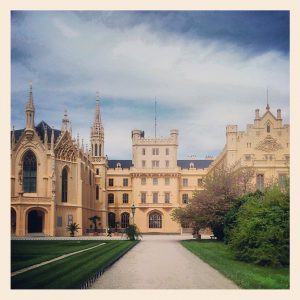 This chateau in south Moravia is pure Neo-Gothic. The exterior alone is enough to fill visitors with awe. The rooms inside dazzle with their astounding original furnishings, exquisitely carved wood paneling, and stunning, vibrant wallpaper. But that is not all there is to see at Lednice Chateau. The park is dotted with wonders, too.
This chateau in south Moravia is pure Neo-Gothic. The exterior alone is enough to fill visitors with awe. The rooms inside dazzle with their astounding original furnishings, exquisitely carved wood paneling, and stunning, vibrant wallpaper. But that is not all there is to see at Lednice Chateau. The park is dotted with wonders, too.
The Lednice-Valtice aerial
The area that includes the Lednice and Valtice chateaus is a large park that encompasses 2,200 hectares and has been recognized by UNESCO on its World Cultural and National Heritage List. Many romantic buildings can be found in this aerial of natural beauty.
The beginnings of Lednice and the Liechtensteins
Lednice can trace its history back to 1222 when it was a Gothic fort. At the end of that century, Lednice became the property of the Liechtensteins, a noble clan who also owned nearby Mikulov and would much later build Valtice Chateau, which was the property of the Liechtensteins from 1395 to 1945. Lednice would be their family property for some 700 years and would become their summer residence.
Becoming the wealthiest family in Moravia
During the 16th century, Lednice became a Renaissance chateau. Karel Liechtenstein served as the representative leader of Moravia in the early 17th century and was given the title of prince. When the Czech Protestant nobility rebelled against the Catholic Habsburgs, the Liechtensteins supported the monarchy, so they were not punished when the Protestants lost. After that the Liechtensteins prospered, becoming the richest noble clan in all of Moravia.
Baroque and Neo-Gothic renovations
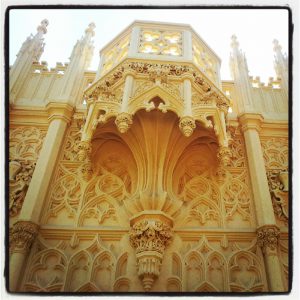 During the end of the 17th century, Lednice Chateau underwent Baroque renovations, but its current look comes from the Neo-Gothic transformation that took place from 1846 to 1858 when Prince Alois Liechtenstein was strongly influenced by English Gothic architecture. Because the Liechtensteins were able to remove many furnishings during World War II, most of the original interior décor was salvaged.
During the end of the 17th century, Lednice Chateau underwent Baroque renovations, but its current look comes from the Neo-Gothic transformation that took place from 1846 to 1858 when Prince Alois Liechtenstein was strongly influenced by English Gothic architecture. Because the Liechtensteins were able to remove many furnishings during World War II, most of the original interior décor was salvaged.
The chateau church and Knighthood Hall
The chateau Church of St. James the Greater shows off incredible 19th-century network vaulting that was inspired by the Gothic style of medieval times. The Knighthood Hall exhibits Neo-Gothic vaulting.
The library and Turquoise Social Lounge
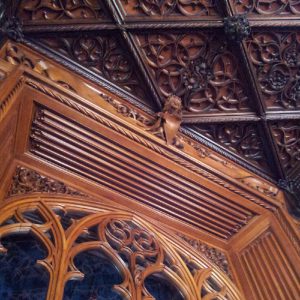 The library is sure to amaze with its winding staircase of richly carved oak wood, created in 1850. The wood decoration on the staircase features details of birds, grapes, and leaves, for instance. That is not all there is to see in the library, though. The wood paneling is breathtaking, complemented by dark blue wallpaper. Even the woodwork on the door is exquisite. The Turquoise Social Lounge is named after its turquoise wallpaper and also features exceptionally carved wood décor as well as a superb chandelier.
The library is sure to amaze with its winding staircase of richly carved oak wood, created in 1850. The wood decoration on the staircase features details of birds, grapes, and leaves, for instance. That is not all there is to see in the library, though. The wood paneling is breathtaking, complemented by dark blue wallpaper. Even the woodwork on the door is exquisite. The Turquoise Social Lounge is named after its turquoise wallpaper and also features exceptionally carved wood décor as well as a superb chandelier.
The Chinese Lounge, Oriental Salon, and Red Smoking Lounge
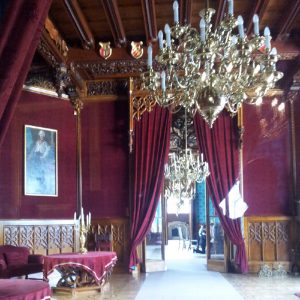 The Chinese Lounge is another delight, boasting astounding wallpaper, royal blue furnishings, and a Chinese lantern. The walls of the Oriental Salon are covered with hand-painted wallpaper forged from Chinese paper. Early 18th-century Chinese wallpaper shows off an idyllic landscape with figures in bright green hues. The Red Smoking Lounge is another sight to behold with its wine-red wallpaper and lavish furnishings, including stunning chandeliers.
The Chinese Lounge is another delight, boasting astounding wallpaper, royal blue furnishings, and a Chinese lantern. The walls of the Oriental Salon are covered with hand-painted wallpaper forged from Chinese paper. Early 18th-century Chinese wallpaper shows off an idyllic landscape with figures in bright green hues. The Red Smoking Lounge is another sight to behold with its wine-red wallpaper and lavish furnishings, including stunning chandeliers.
More rooms sure to impress
The Family Hall exudes simple elegance. A collection of graphics in the Lounge of Sofie Esterhazy is sure to impress. The collection of porcelain throughout the chateau is stunning as well. Do not overlook the elegant desk in Princess Frances’ Bedroom. One of the finest furnishings in the chateau includes the Neo-Gothic chairs with exquisite, intricate patterns on their backs.
Features of the chateau park
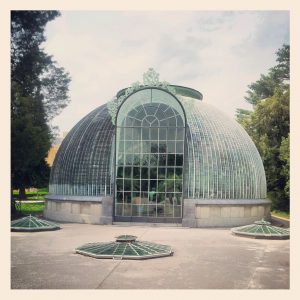 The park is just as impressive as the chateau. The greenhouse with an arched roof was ahead of its time when it was constructed in the middle of the 19th century and can be toured, too. The cast-iron structure is 92 meters long, 13 meters wide, and 10 meters high. Cast-iron columns look like bamboo trunks. One of the highlights of the park is the Moorish-style Minaret, created from 1797 to 1804. It includes ground-floor arcades, eight rooms on the upper floor, and a three-story tower with a gallery. A helmet and half-moon crown the breathtaking structure. Jan’s Castle, romantic imitation castle ruins created in the 19th century, is not to be missed, either.
The park is just as impressive as the chateau. The greenhouse with an arched roof was ahead of its time when it was constructed in the middle of the 19th century and can be toured, too. The cast-iron structure is 92 meters long, 13 meters wide, and 10 meters high. Cast-iron columns look like bamboo trunks. One of the highlights of the park is the Moorish-style Minaret, created from 1797 to 1804. It includes ground-floor arcades, eight rooms on the upper floor, and a three-story tower with a gallery. A helmet and half-moon crown the breathtaking structure. Jan’s Castle, romantic imitation castle ruins created in the 19th century, is not to be missed, either.
Exploring both Lednice and Valtice
Do not overlook the nearby Valtice Chateau while in the area, as its chapel ranks as one of the most superb examples of Baroque architecture in Central Europe. Other rooms do not disappoint, either. While both Lednice and Valtice can be visited in one day, it is a good idea to take an entire day to explore Lednice Chateau and its grounds.
Tours offered at Lednice Chateau
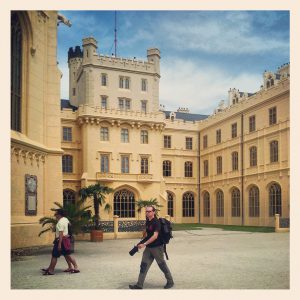 There are eight tours offered at Lednice Chateau. The representative rooms on the ground floor comprise one tour while the princely apartments are shown off during another. It is also possible to see the Children’s Room and the Room of Marionettes as well as the grotto, an artificial Baroque cave with a ghost exhibition. The greenhouse, the Minaret, John’s Castle, and the Apollo Temple, a romantic chateau from 1817, are four more possibilities.
There are eight tours offered at Lednice Chateau. The representative rooms on the ground floor comprise one tour while the princely apartments are shown off during another. It is also possible to see the Children’s Room and the Room of Marionettes as well as the grotto, an artificial Baroque cave with a ghost exhibition. The greenhouse, the Minaret, John’s Castle, and the Apollo Temple, a romantic chateau from 1817, are four more possibilities.




